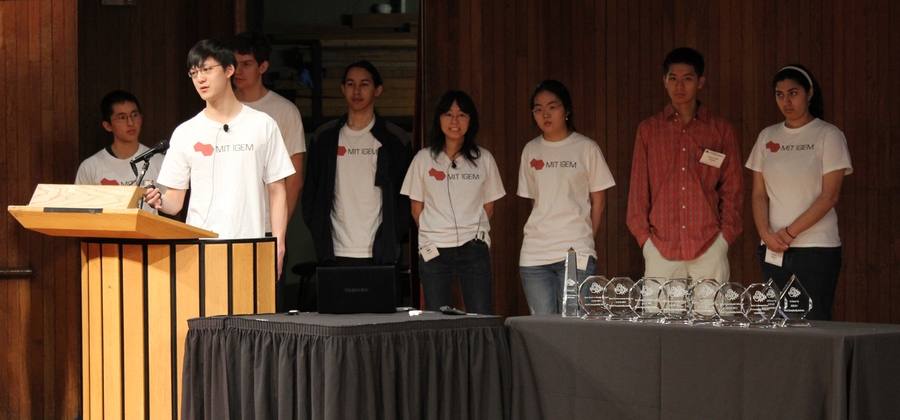In this year’s International Genetically Engineered Machines (iGEM) competition, where undergraduate students from across the world competed to build biological systems and operate them in living cells, the team from MIT placed first in the health and medicine track and fourth overall out of 160 teams.
The iGEM competition, which began in 2003 with a monthlong course during MIT’s Independent Activities Period, has grown to include teams from the Americas, Europe and Asia. Over the course of several months, student teams design novel biological systems from a standard kit of biological parts. Three regional “jamborees” then lead up to the world championship, which was held Nov. 5-7 at MIT.
This year’s MIT team used synthetic biology and genetic-circuit engineering to control intercellular communication and logic processing in mammalian cells. The students focused on the autonomous formation of patterns in a population of cells as the first step in this novel approach to engineering tissues. By adapting natural genetic elements involving the Notch-Delta signaling system, cadherin adhesion proteins and common internal logic processing motifs, the team designed a system that would allow for the emergence of organized patterns from a population of engineered cells.
Mammalian work is rare in iGEM, meaning the MIT team contributed a large number of mammalian DNA parts that they designed, constructed and tested to the parts registry, significantly increasing the total number of mammalian resources for other researchers to access.
The health and medicine track was one of 10 tracks in this year’s competition, and MIT also placed in the grand finals for the first time this year. The overall grand prize was ultimately awarded to a team from the University of Washington, with teams from Imperial College London and China’s Zhejiang University placing second and third.
“This year our project moved beyond the scope of traditional iGEM projects and it took us quite some time to gain a basic intuitive feel for the complex population-level dynamics involved,” said MIT sophomore Charles Hsu. “At the Americas regionals we had some difficulty conveying the complexity of our system, but continued team effort was strong and I think we really came across with our designs and results at the worlds. It was great to see what other teams came up with too, as the projects just keep getting more and more exciting year after year.”
Representing MIT at the iGEM world championships jamboree this year were presenters Hsu, Jenny Cheng '11 and senior Kenneth Hu, along with junior Grant Robinson, sophomores Jonathan Chien, Clara Park and Divya Arcot, and high school senior Semon Rezchikov. Other team members involved over the course of the summer were senior Tyler Wagner, sophomores Tiffany Huang and Michelle Dion, and Hunter College senior Mariola Szenk.
The team was instructed by MIT associate professor Ron Weiss and instructors Jonathan Babb and Deepak Mishra. Additional support was provided by the Elowitz group at the California Institute of Technology for cell lines and DNA; the MIT departments of Electrical Engineering and Computer Science, Biological Engineering, and Biology; and corporate sponsors EMD-Millipore, Genewiz, Geneious, Ginkgo Bioworks, Addgene, EmbiTec, BBN Technologies, EBICS and New England Biolabs.
The iGEM competition, which began in 2003 with a monthlong course during MIT’s Independent Activities Period, has grown to include teams from the Americas, Europe and Asia. Over the course of several months, student teams design novel biological systems from a standard kit of biological parts. Three regional “jamborees” then lead up to the world championship, which was held Nov. 5-7 at MIT.
This year’s MIT team used synthetic biology and genetic-circuit engineering to control intercellular communication and logic processing in mammalian cells. The students focused on the autonomous formation of patterns in a population of cells as the first step in this novel approach to engineering tissues. By adapting natural genetic elements involving the Notch-Delta signaling system, cadherin adhesion proteins and common internal logic processing motifs, the team designed a system that would allow for the emergence of organized patterns from a population of engineered cells.
Mammalian work is rare in iGEM, meaning the MIT team contributed a large number of mammalian DNA parts that they designed, constructed and tested to the parts registry, significantly increasing the total number of mammalian resources for other researchers to access.
The health and medicine track was one of 10 tracks in this year’s competition, and MIT also placed in the grand finals for the first time this year. The overall grand prize was ultimately awarded to a team from the University of Washington, with teams from Imperial College London and China’s Zhejiang University placing second and third.
“This year our project moved beyond the scope of traditional iGEM projects and it took us quite some time to gain a basic intuitive feel for the complex population-level dynamics involved,” said MIT sophomore Charles Hsu. “At the Americas regionals we had some difficulty conveying the complexity of our system, but continued team effort was strong and I think we really came across with our designs and results at the worlds. It was great to see what other teams came up with too, as the projects just keep getting more and more exciting year after year.”
Representing MIT at the iGEM world championships jamboree this year were presenters Hsu, Jenny Cheng '11 and senior Kenneth Hu, along with junior Grant Robinson, sophomores Jonathan Chien, Clara Park and Divya Arcot, and high school senior Semon Rezchikov. Other team members involved over the course of the summer were senior Tyler Wagner, sophomores Tiffany Huang and Michelle Dion, and Hunter College senior Mariola Szenk.
The team was instructed by MIT associate professor Ron Weiss and instructors Jonathan Babb and Deepak Mishra. Additional support was provided by the Elowitz group at the California Institute of Technology for cell lines and DNA; the MIT departments of Electrical Engineering and Computer Science, Biological Engineering, and Biology; and corporate sponsors EMD-Millipore, Genewiz, Geneious, Ginkgo Bioworks, Addgene, EmbiTec, BBN Technologies, EBICS and New England Biolabs.






